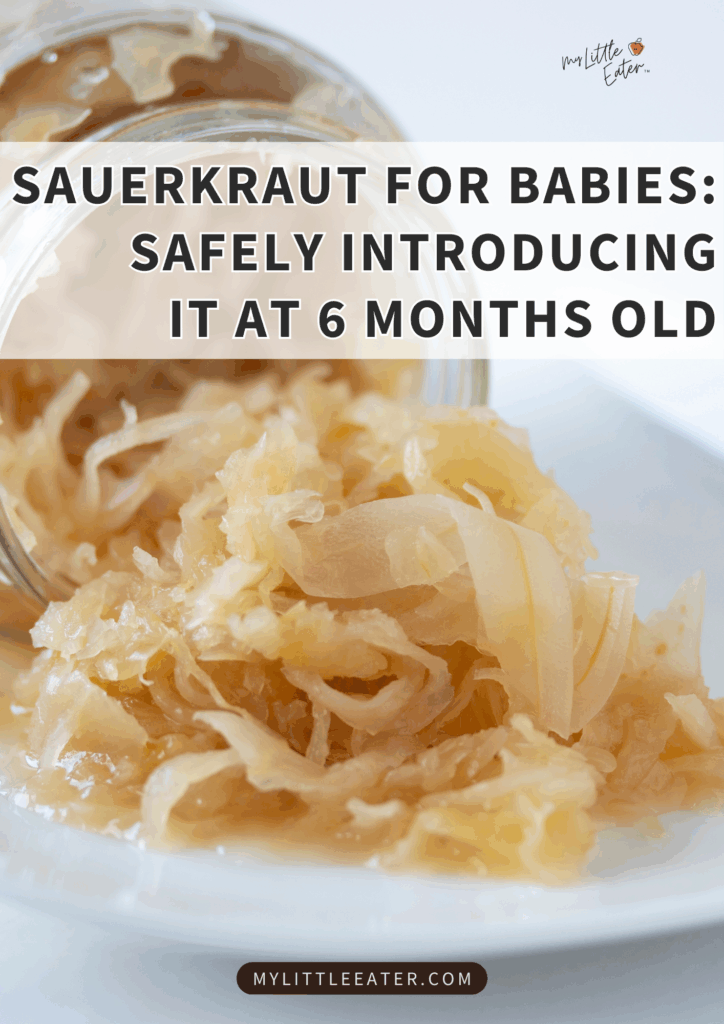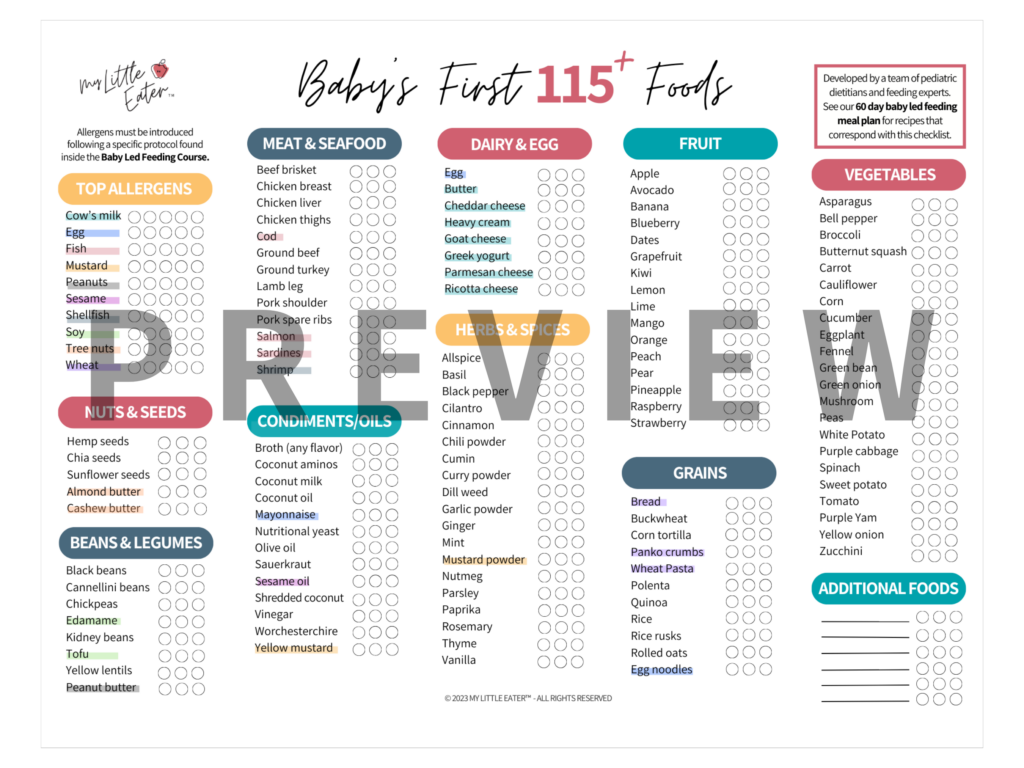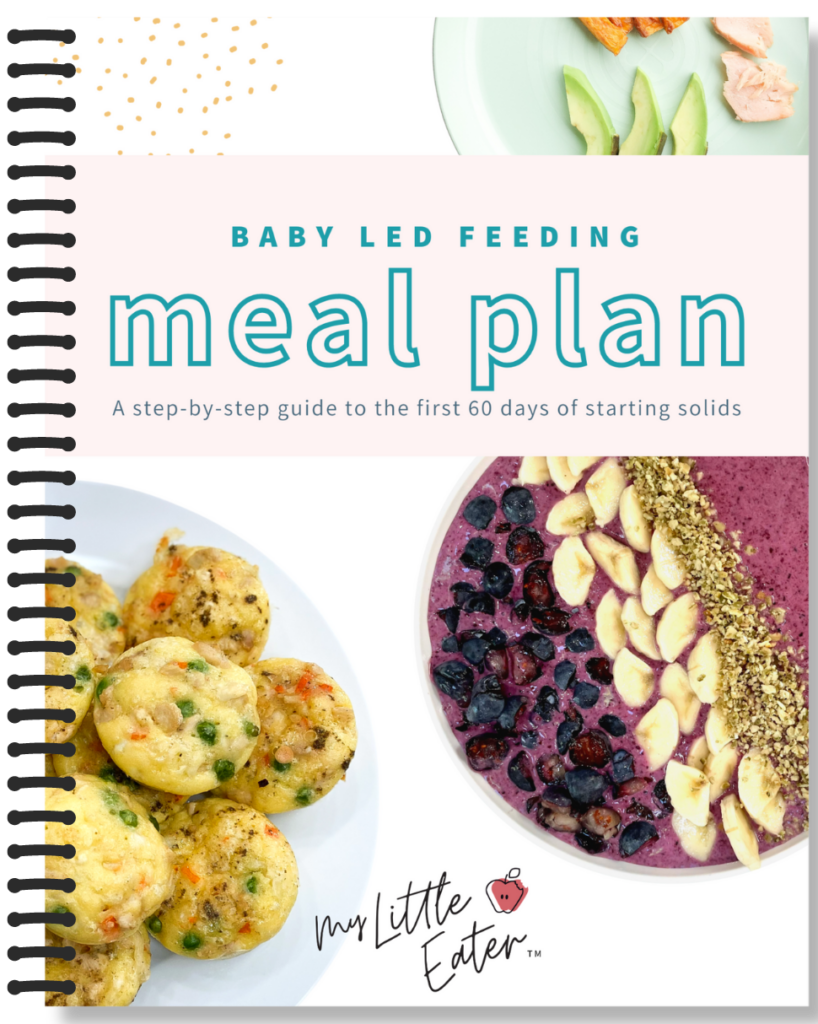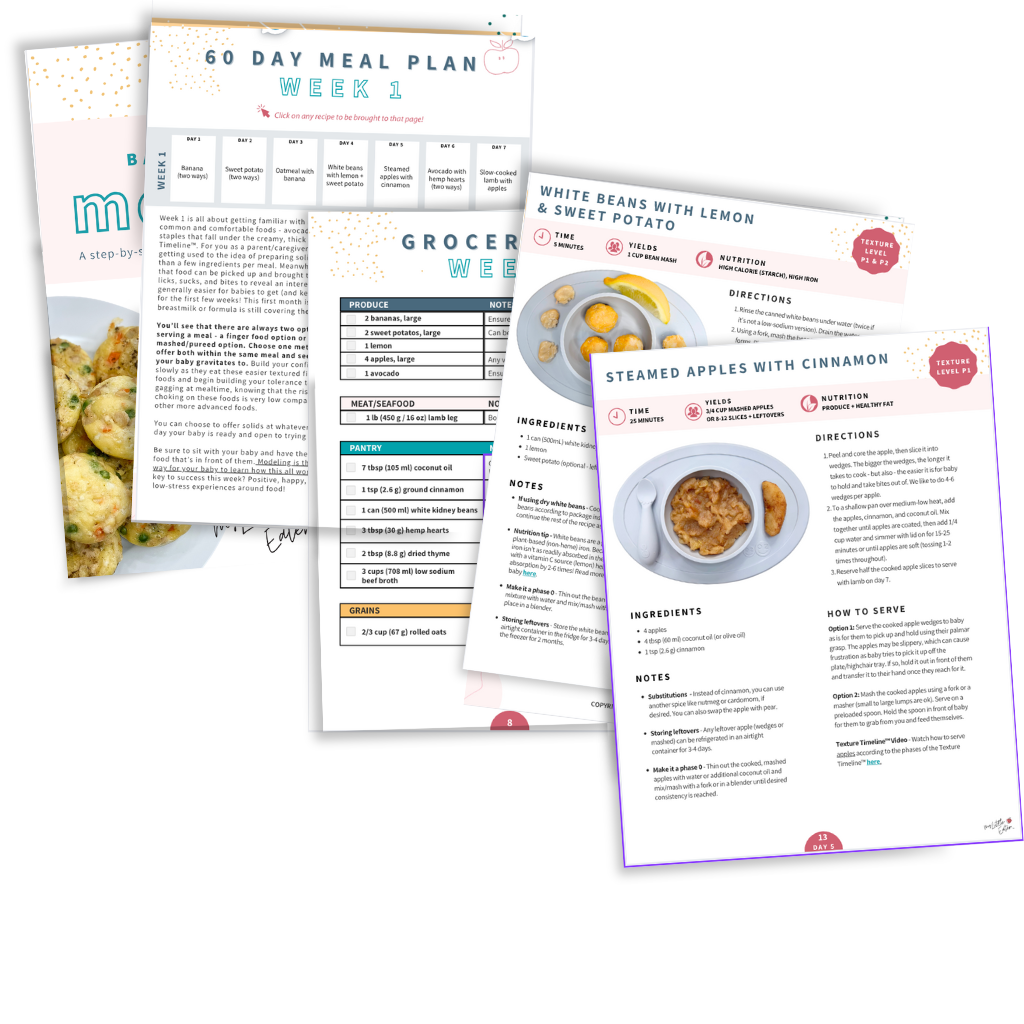Sauerkraut is a fermented food that’s made from thinly shredded cabbage. With a sour, almost tangy flavor, it packs a punch and is unique from the taste of many other foods, making it a great food to introduce to your baby to help expand their palate.
By introducing more variety in flavors and textures, you’re helping to prevent picky eating as they get older, plus sauerkraut has many nutritional benefits, so it’s a win-win!
Table of Contents
When can babies eat sauerkraut?
Although fermented foods, like sauerkraut, aren’t typically thought of when choosing first foods for babies, they can be served from the beginning of starting solids.
That means that sauerkraut is safe to serve from about 6 months old, or whenever your baby is showing all of the signs of developmental readiness to begin solid foods.
Watch baby Lyla eat sauerkraut after starting solids!
Watch baby Lyla eat sauerkraut after starting solids!
Lyla is 9 months old and enjoying sauerkraut as a side to her baby meal.
Is sauerkraut a choking hazard for babies?
Sauerkraut is not a common choking hazard for babies. Traditional sauerkraut is made to be a finely shredded texture, which babies can chew using the pressure of their gums, even before they have teeth.
To make it easier for your baby to handle long strands of sauerkraut, we recommend chopping it into pieces that are about ½ inch long. This will make the sauerkraut more manageable for your baby to chew and swallow safely.
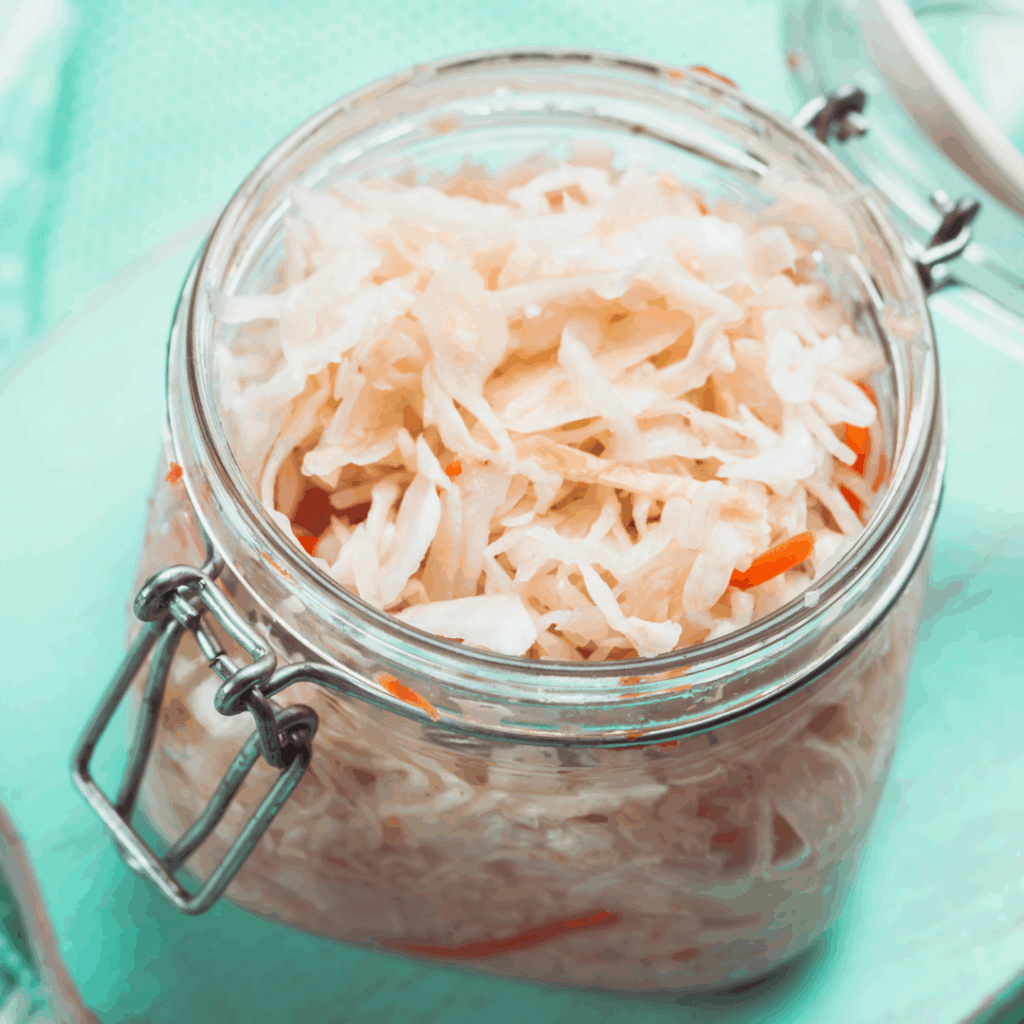
Note: While store-bought sauerkraut is typically finely shredded, homemade versions sometimes contain larger chunks of cabbage, which could be harder for your baby to chew and swallow properly. When buying or making sauerkraut, opt for a finely shredded texture. Alternatively, large pieces of sauerkraut can be blended for new eaters.
Always make sure that you’re offering your baby appropriate foods based on their skill level and ability to chew their food thoroughly.
How to serve sauerkraut according to the Texture Timeline™
These are the safest, suggested ways to serve food to your baby based on the scientific, developmental, and clinical research and expertise available to date and are vetted by pediatric doctors, speech-language pathologists, and dietitians. However, please note that babies can technically choke on anything, including purees. Always take into account your child’s individual abilities and needs and check with your doctor or feeding therapist on the safety of offering these foods to your baby. Be mindful of how to set up a safe eating environment and please know that all material, opinions, advice, and information found on mylittleeater.com is for informational and educational purposes only. See our disclaimer for more information.
What is the Texture Timeline™?
A tool exclusive to My Little Eater that allows you to start solids with your baby using purées, finger foods, or a mixture of both. We sort all foods into different phases of the timeline based on texture difficulty, presenting multiple ways to serve each food depending on what you and your baby are ready for.
You can start with any phase of the Texture Timeline™. The goal is to always be moving forward on the timeline so that you can advance your baby to more challenging textures in a timely manner. This will allow your baby to develop and practice new eating skills and ensure that they don’t stay stuck on one texture for too long.
Using the Texture Timeline™ can help to prevent picky eating, all while keeping the feeding process enjoyable and less stressful for you because you can ease into the difficult textures that often cause more anxiety and worry.
Texture Timeline™ Phase 0
Thin purée (Utensil)
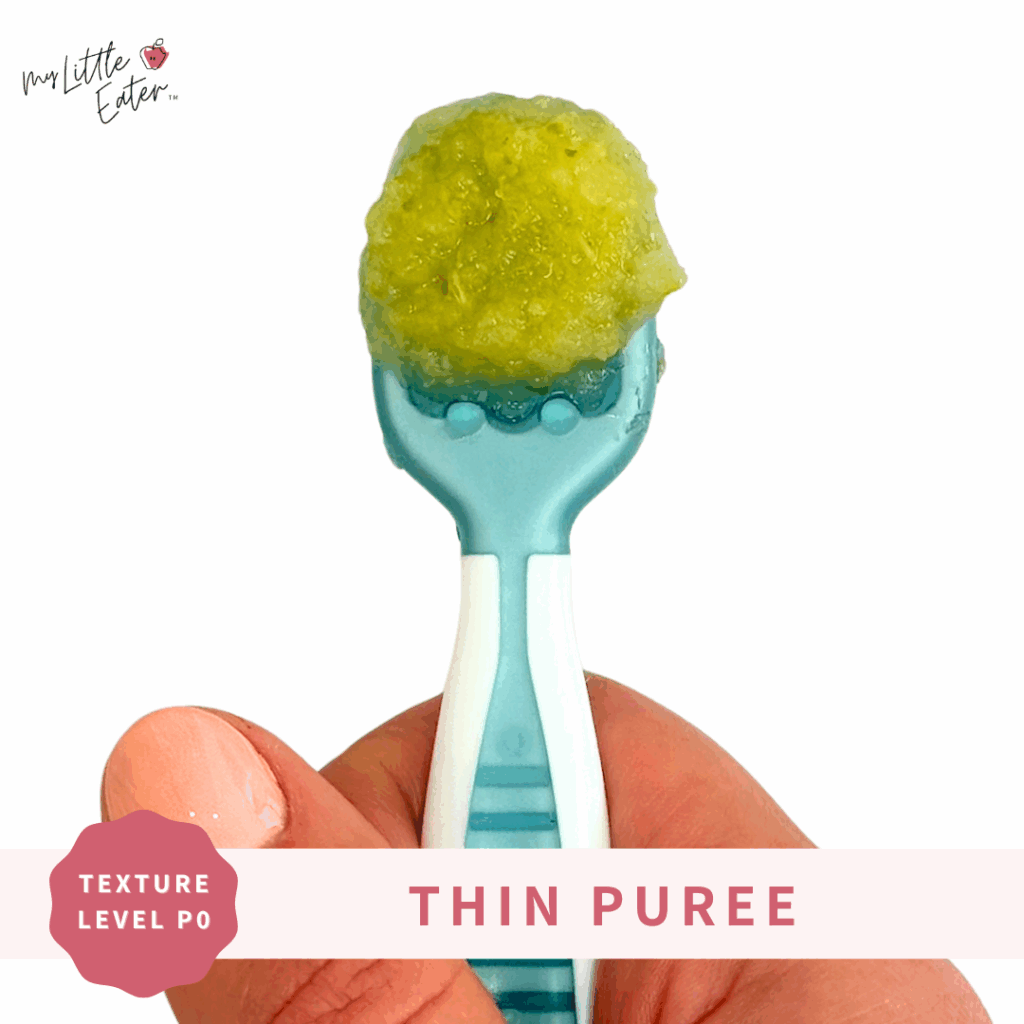
Blend sauerkraut with a bit of water, breastmilk, or formula until you have a thin, smooth purée that runs easily off of a spoon when tilted (aim for the texture of smooth applesauce). Serve this to your baby on a preloaded spoon.
Texture Timeline™ Phase 2
Shredded sauerkraut, mixed into a purée (Utensil)
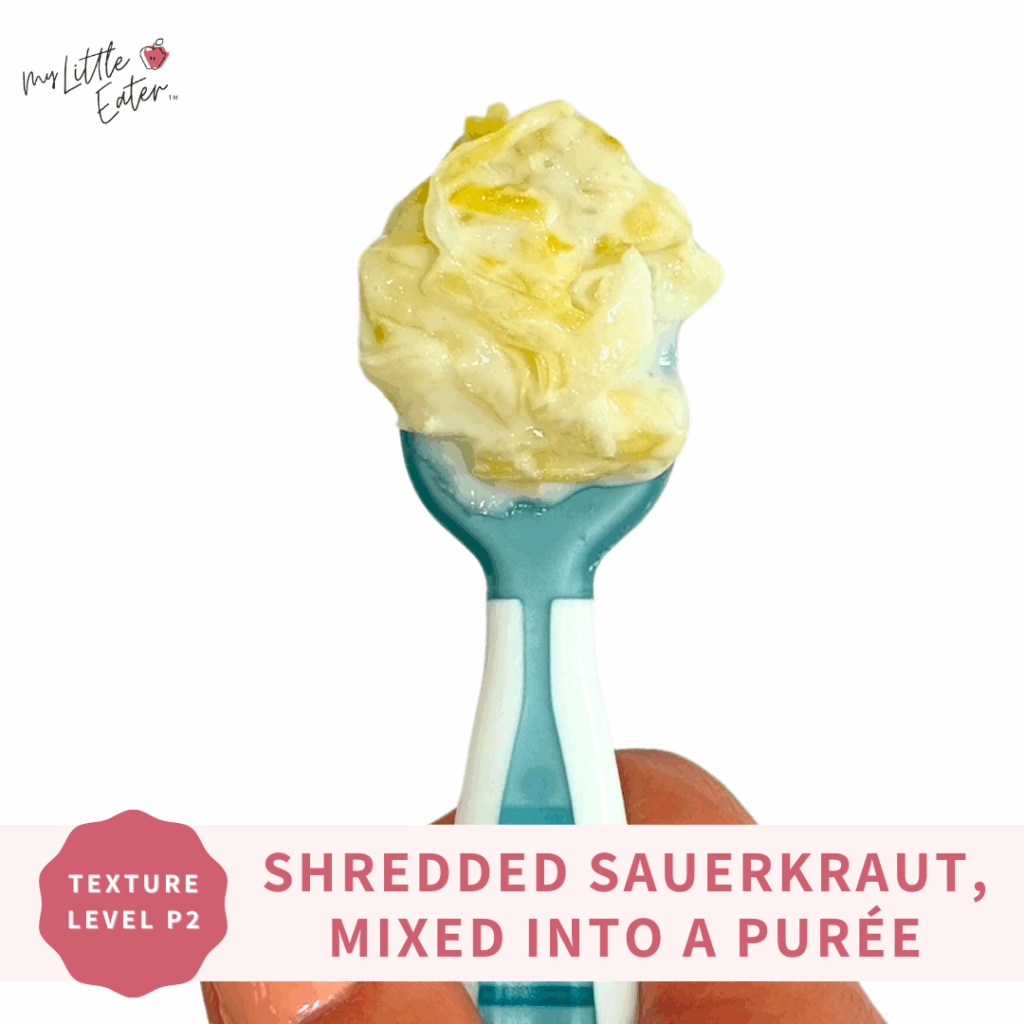
Step 1: Mix shredded sauerkraut into a binding purée like mashed potato or hummus (aim for a 1:1 ratio of sauerkraut to purée).
Note: If the sauerkraut that you’re using has very long strands, use a sharp knife to finely chop it (aim for strands about ½ of an inch in length). Reducing the length of the shredded strands will make them more manageable for your baby to manipulate in their mouth.
Step 2: Serve to your baby on a preloaded spoon. Or, if your baby isn’t interested in eating from a spoon, you can let them get messy and dig in with their hands!
Texture Timeline™ Phase 3
Shredded sauerkraut (Utensil/Pincer Grasp)
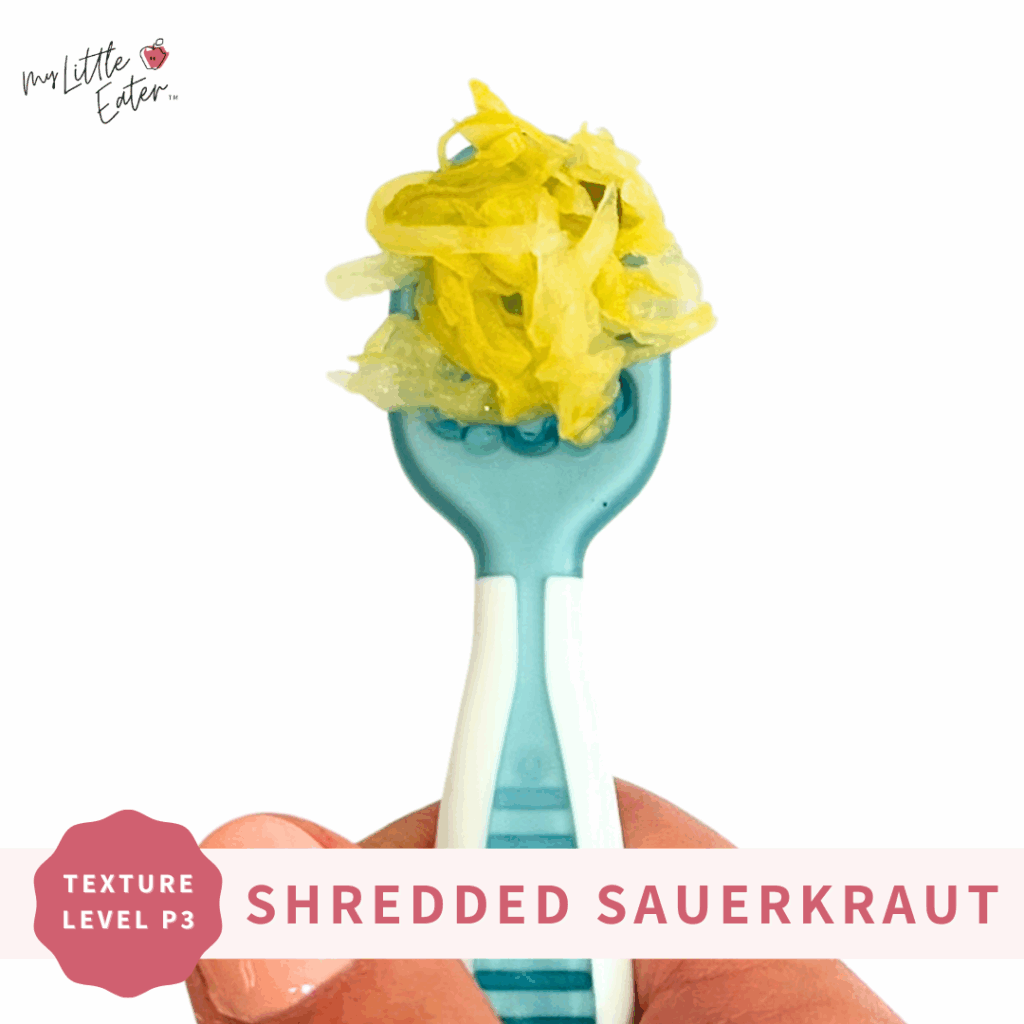
Serve shredded sauerkraut to your baby on a preloaded spoon. Or if your baby has their pincer grasp, you can dump a small pile of shredded sauerkraut onto your baby’s tray and allow them to pick it up using their hands!
Note: If the sauerkraut that you’re using has very long strands, use a sharp knife to finely chop it (aim for strands about ½ of an inch in length). Reducing the length of the shredded strands will make them more manageable for your baby to manipulate in their mouth.
Fun fact!
Fun fact!
The word “sauerkraut” is German for “sour cabbage”. Despite its German name, sauerkraut is said to have originated from China over 2000 years ago (16).
Nutritional benefits
Sauerkraut is high in vitamin K, supporting bone health and normal blood clotting (7).
It’s also a good source of fiber and provides probiotics (due to it being a fermented food), both of which can help to support healthy digestion (1,2,8).
Other nutrients found in sauerkraut include:
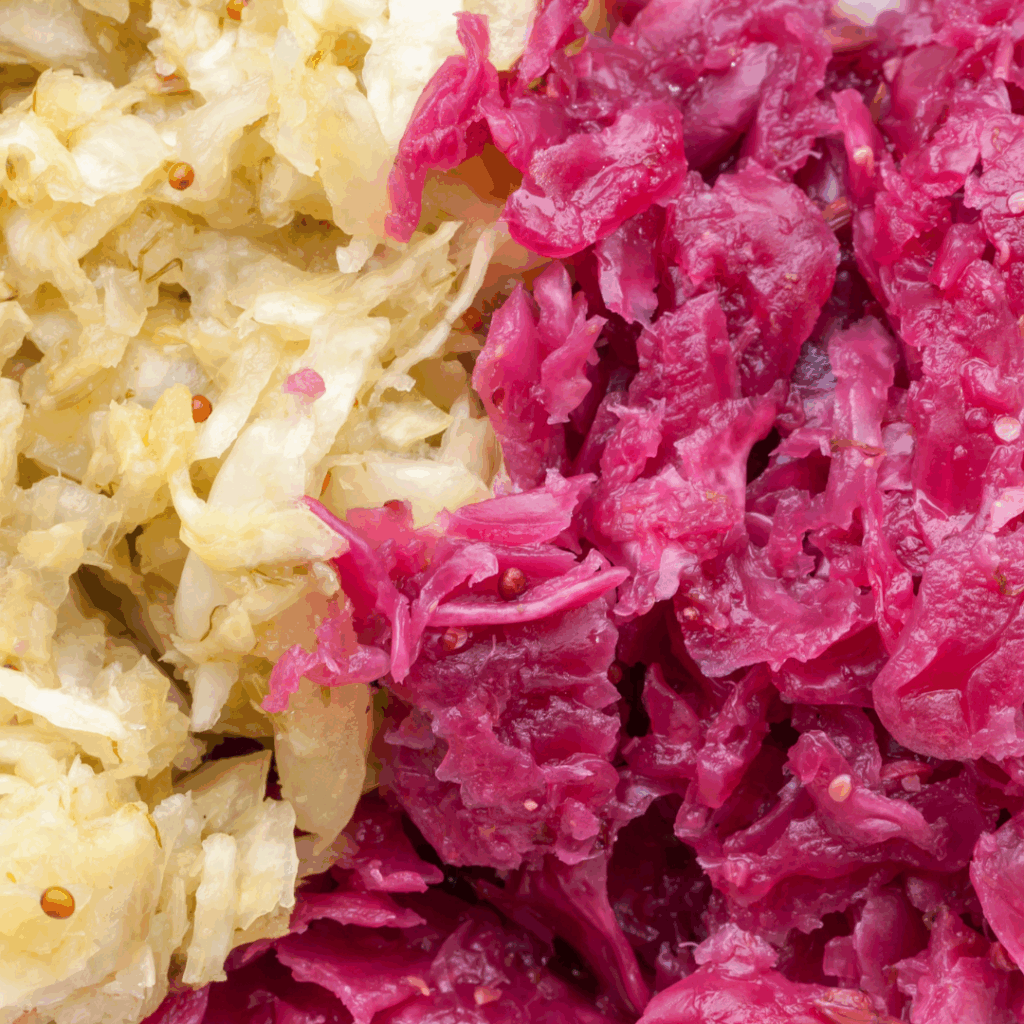
- Magnesium: For normal muscle and nerve function (9).
- Potassium: Helps regulate blood pressure (10).
- Vitamin C: For immune function and the absorption of non-heme iron from plant-based foods (like beans, lentils, and tofu) (11,12).
- Folate: Plays a role in the formation of healthy red blood cells and brain development (13,14).
- Vitamin B6: For brain development, healthy immune function, the production of red blood cells, and the metabolism of carbohydrates, protein, and fat (15).

A note about pasteurization
When choosing sauerkraut for your baby, always choose one that has been pasteurized.
Unpasteurized food products carry an increased risk of foodborne illness, which babies are more vulnerable to due to their underdeveloped immune systems.
Fermented foods tip!
Fermented foods tip!
While sauerkraut has many nutritional benefits, it can cause some bloating and stomach upset or discomfort if you aren’t used to eating fermented foods or foods with healthy bacteria.
Because of this, we recommend starting small and offering only a little bit of sauerkraut the first few times you serve it to help your baby’s digestive system get used to it before allowing them to eat more.
Sodium concerns
Sauerkraut is high in sodium, just as other fermented foods are. For this reason, we recommend rinsing it under cold water before serving it to babies under 12 months of age to reduce the sodium content.
It’s also important to balance the meal with other foods that are not high in sodium. Be aware of other foods being offered throughout the day to help limit their overall sodium consumption.
That said, the benefits of introducing a small amount of sauerkraut to your baby outweigh the risks from the amount of sodium it contains, especially if you rinse it first.
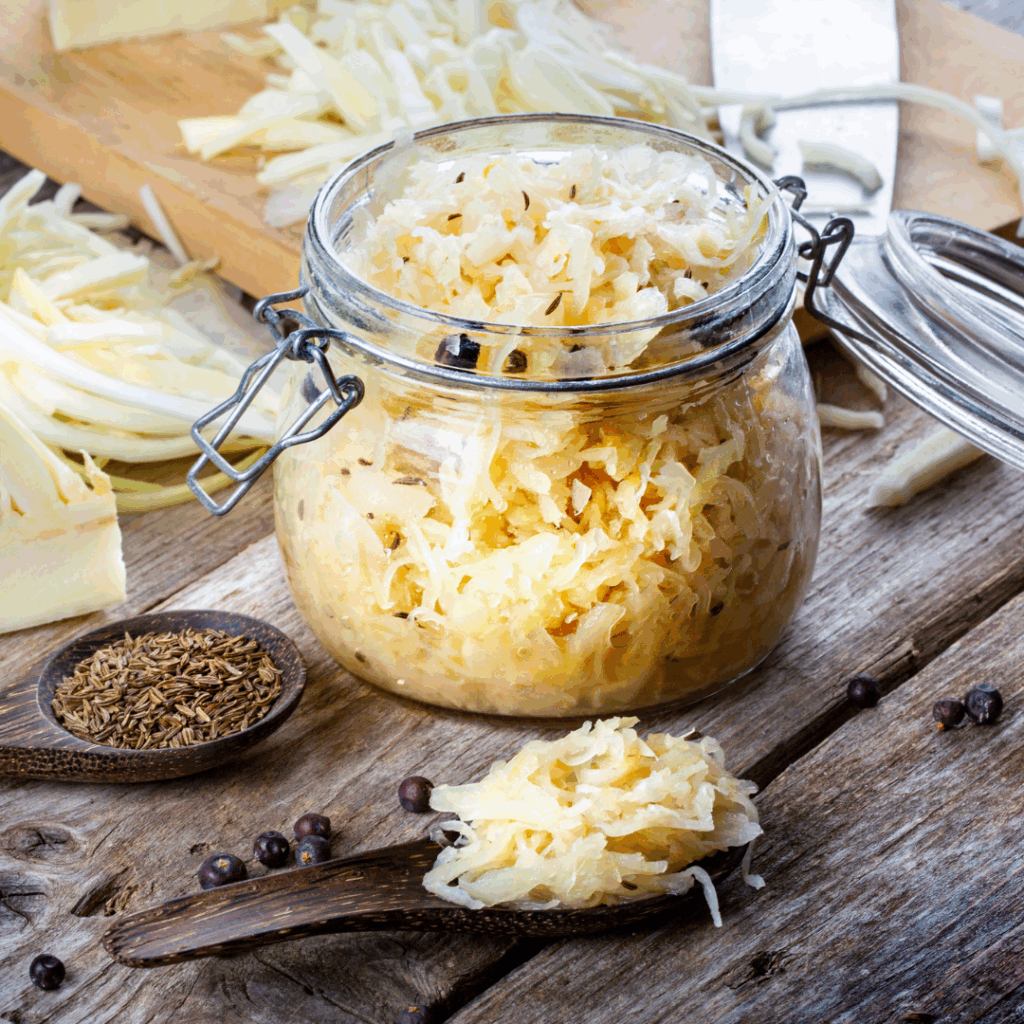
Recommended next...
Learn all about how to introduce fermented foods to your baby – including yogurt, kefir, kimchi, and more!
Can babies be allergic to sauerkraut?
Sauerkraut is not considered to be one of the top 10 allergenic foods for babies.
However, while allergies to sauerkraut are rare they’re not impossible. Sauerkraut is made with cabbage, which can sometimes trigger an allergic reaction called oral allergy syndrome (OAS), (commonly called Pollen Food Allergy Syndrome (PFAS)). This type of allergy is most likely to occur in those who are allergic to mugwort pollen, as the proteins in cabbage are similar to proteins found in this type of pollen (3,4).
With OAS, the body’s immune system confuses the similar proteins in food for the ones found in pollen and therefore reacts to the proteins as an allergen. OAS is considered to be a mild food allergy with common symptoms being itchiness or swelling of the mouth, face, lips, tongue, or throat (5). Symptoms usually occur within a few minutes, but can appear up to an hour after eating (5).
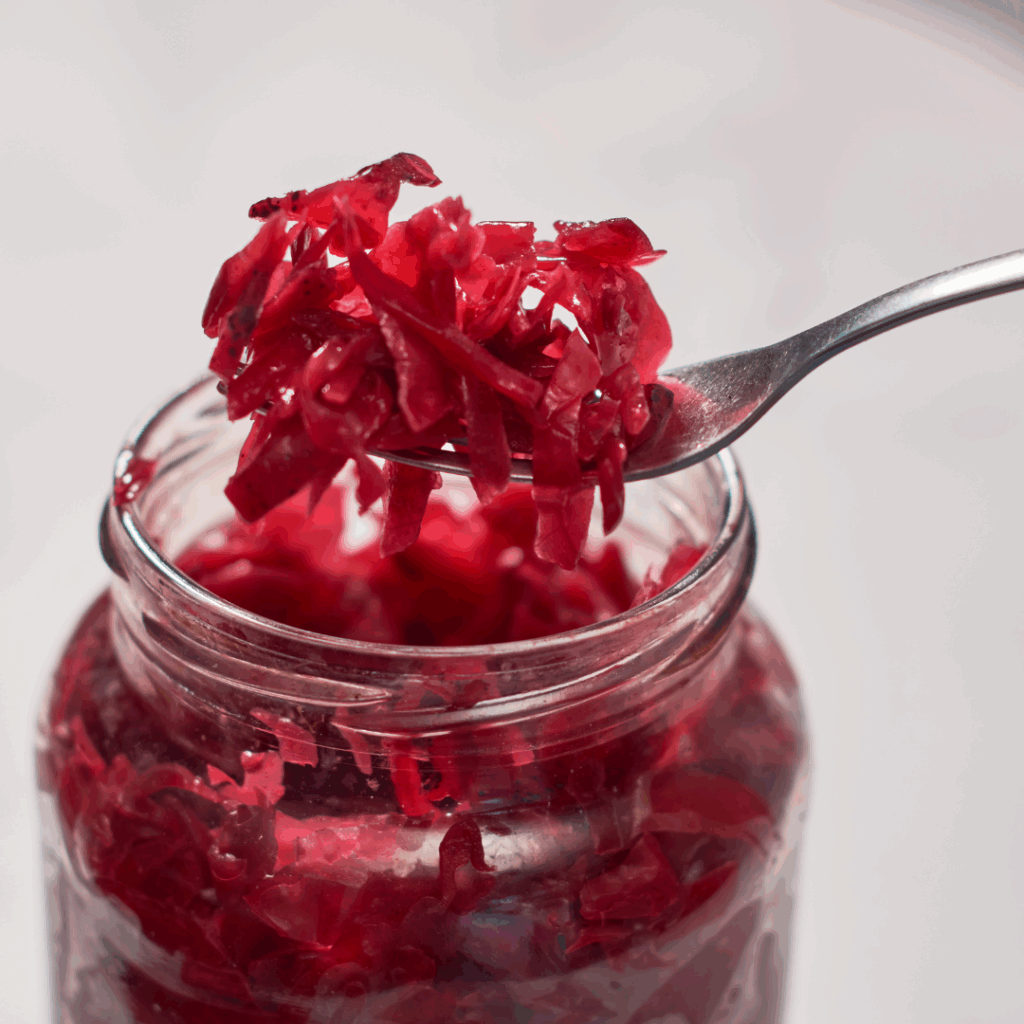
It should also be noted that store-bought sauerkraut can sometimes contain additional ingredients such as mustard, which is one of the top 10 allergenic foods in Canada (6).
Always read the ingredients label closely before serving sauerkraut (or any pre-packaged food) to your baby so that you can be aware of any potential allergens it may contain.
To find all the in-depth, research-backed info for starting solids in one place, and to get access to our signature Texture Timeline™ that has been tried and tested by thousands of parents, sign up for our Baby Led Feeding Program!
Learn all about introducing solid foods the way that you and your baby want to start, and about how to advance your baby in textures from there.
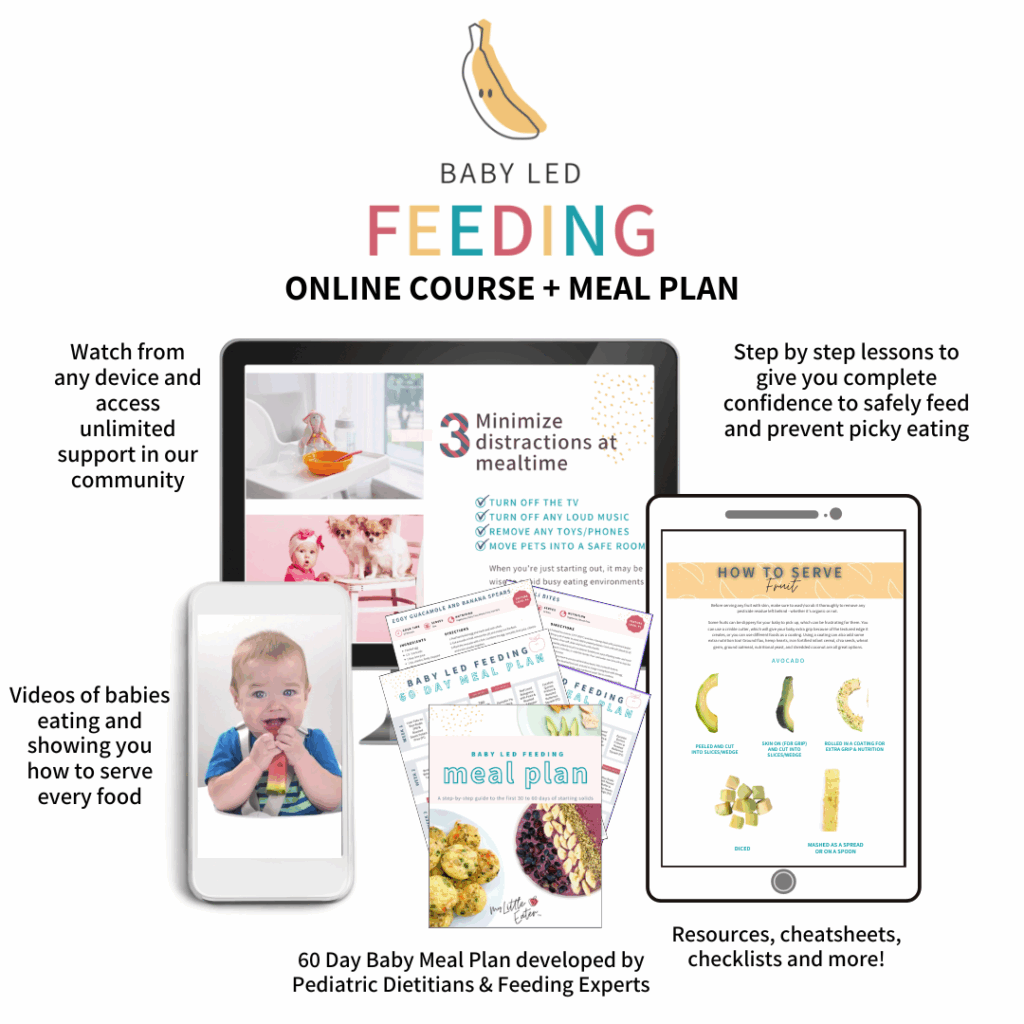
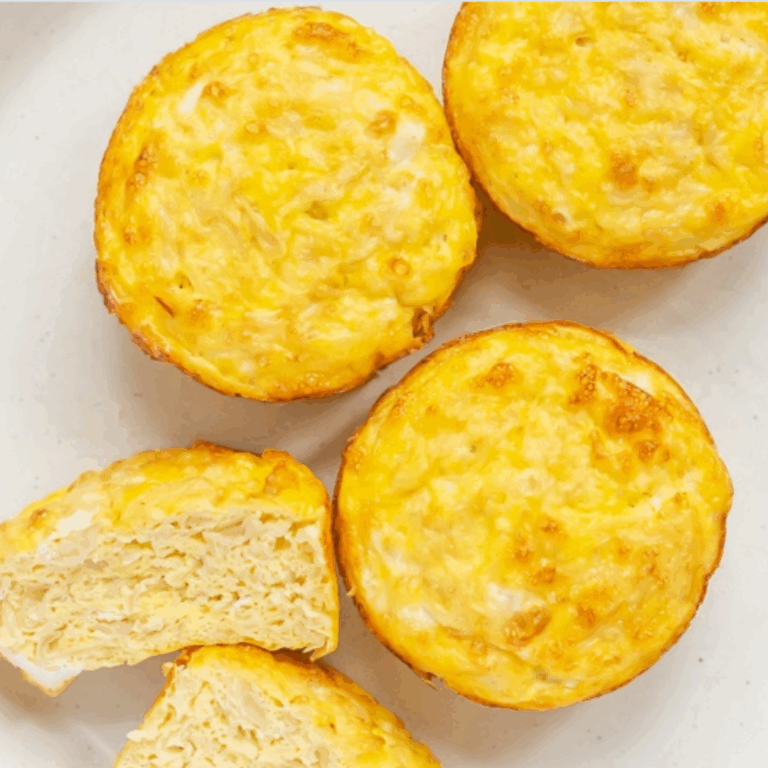
Sauerkraut Egg Cups for Baby Led Weaning
Equipment
- 1 muffin pan
- Parchment muffin liners
Ingredients
- 1 ½ tsp Extra virgin olive oil
- 5 Eggs (whisked)
- 1 cup Sauerkraut (rinsed and drained)
- 2 tbsp Milk
Instructions
- Preheat the oven to 375ºF (190ºC). Grease a muffin pan with the olive oil or use parchment muffin liners.
- In a bowl, whisk together the eggs, sauerkraut, and milk. Pour the mixture into the muffin pan, almost to the top of each compartment.
- Bake in the oven for 20 to 25 minutes or until the egg cups are golden brown and cooked through. Enjoy!
Video
Notes
Pin this info to save for later!
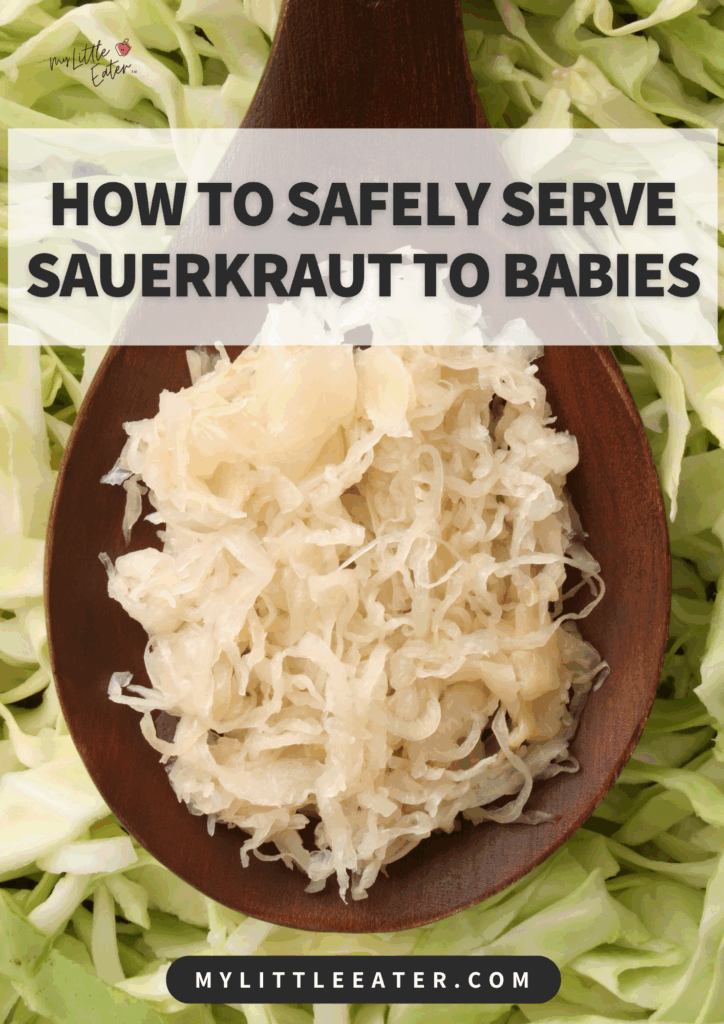
References
- U.S. Department of Agriculture. (2019). Sauerkraut, canned, solids and liquids. https://fdc.nal.usda.gov/food-details/169279/nutrients
- Marco, M. L., Heeney, D., Binda, S., Cifelli, C. J., Cotter, P. D., Foligné, B., Gänzle, M., Kort, R., Pasin, G., Pihlanto, A., Smid, E. J., & Hutkins, R. (2017). Health benefits of fermented foods: microbiota and beyond. Current opinion in biotechnology, 44, 94–102. https://doi.org/10.1016/j.copbio.2016.11.010
- American Academy of Allergy Asthma & Immunology. (2024). Oral Allergy Syndrome (OAS). https://www.aaaai.org/tools-for-the-public/conditions-library/allergies/oral-allergy-syndrome-(oas)
- Palacín, A., Cumplido, J., Figueroa, J., Ahrazem, O., Sánchez-Monge, R., Carrillo, T., Salcedo, G., & Blanco, C. (2006). Cabbage lipid transfer protein Bra o 3 is a major allergen responsible for cross-reactivity between plant foods and pollens. The Journal of allergy and clinical immunology, 117(6), 1423–1429. https://doi.org/10.1016/j.jaci.2006.01.026
- Kelava, N., Lugović-Mihić, L., Duvancić, T., Romić, R., & Situm, M. (2014). Oral allergy syndrome–the need of a multidisciplinary approach. Acta clinica Croatica, 53(2), 210–219. The Journal of allergy and clinical immunology, 117(6), 1423–1429. https://doi.org/10.1016/j.jaci.2006.01.026
- Government of Canada. (2023). Common food allergens: priority allergens. https://www.canada.ca/en/health-canada/services/food-nutrition/food-safety/food-allergies-intolerances/food-allergies.html
- Institute of Medicine (US) Panel on Micronutrients. (2001). Dietary Reference Intakes for Vitamin A, Vitamin K, Arsenic, Boron, Chromium, Copper, Iodine, Iron, Manganese, Molybdenum, Nickel, Silicon, Vanadium, and Zinc. National Academies Press (US).
- Brownawell, A.M., Caers, W., Gibson, G.R., Kendall, C.W.C., Lewis, K.D., Ringel, Y., & Slavin, J.L. (2012). Prebiotics and the Health Benefits of Fiber: Current Regulatory Status, Future Research, and Goals. The Journal of Nutrition, 142(5), 962-974. https://doi.org/10.3945/jn.112.158147
- Institute of Medicine (US) Standing Committee on the Scientific Evaluation of Dietary Reference Intakes. (1997). Dietary Reference Intakes for Calcium, Phosphorus, Magnesium, Vitamin D, and Fluoride. National Academies Press (US).
- National Academies of Sciences, Engineering, and Medicine; Health and Medicine Division; Food and Nutrition Board; Committee to Review the Dietary Reference Intakes for Sodium and Potassium, Oria, M., Harrison, M., & Stallings, V. A. (Eds.). (2019). Dietary Reference Intakes for Sodium and Potassium. National Academies Press (US).
- Jacob, R. A., & Sotoudeh, G. (2002). Vitamin C function and status in chronic disease. Nutrition in clinical care: an official publication of Tufts University, 5(2), 66–74. https://doi.org/10.1046/j.1523-5408.2002.00005.x
- Cook, J., & Reddy, M. (2001). Effect of ascorbic acid intake on nonheme-iron absorption from a complete diet. The American journal of clinical nutrition, 73. 93-8. DOI: 10.1093/ajcn/73.1.93.
- Ross, A. C., Caballero, B. H., Cousins, R. J., Tucker, K. L., & Ziegler, T. R. (2012). Modern nutrition in health and disease: Eleventh edition. Wolters Kluwer Health Adis (ESP).
- Irvine, N., England-Mason, G., Field, C. J., Dewey, D., & Aghajafari, F. (2022). Prenatal Folate and Choline Levels and Brain and Cognitive Development in Children: A Critical Narrative Review. Nutrients, 14(2), 364. https://doi.org/10.3390/nu14020364
- Mackey, A., Davis, S., & Gregory, J. (2006). Vitamin B6. Modern Nutrition in Health and Disease. Lippincott Williams and Wilkins, 194-210.
- Howe, H. (2018, August 16). 51 Fascinating Facts About Sauerkraut and Cabbage [WHO KNEW?]. Make Sauerkraut! https://www.makesauerkraut.com/sauerkraut-facts/

Bianca Gruenewald, RD
Bianca is a Registered Dietitian and works in a client support role at My Little Eater Inc. She's a proud auntie to her three year old niece and four year old nephew!

Bianca Gruenewald, RD
Bianca is a Registered Dietitian and works in a client support role at My Little Eater Inc. She's a proud auntie to her three year old niece and four year old nephew!

Mallory Roberts, SLP
Mallory is a Speech-Language Pathologist, Infant Feeding Specialist, and Craniosacral Therapist. She's also a busy mom of four little ones!

Mallory Roberts, SLP
Mallory is a Speech-Language Pathologist, Infant Feeding Specialist, and Craniosacral Therapist. She's also a busy mom of four little ones!
